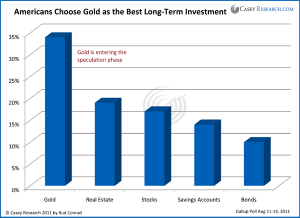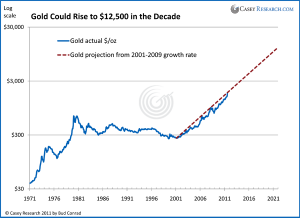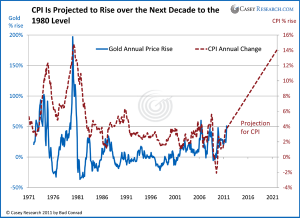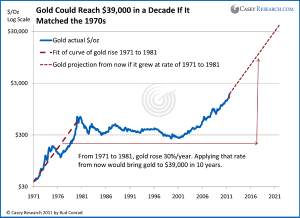Gold Is Entering a New Phase of Public Acceptance
The fundamentals of government deficits and the Fed’s loose monetary policies have, if anything, become worse. We at Casey Research have been pounding the table for years that gold is a must-have, long-term hold for protection against a demise of the dollar. The 700% increase over the decade – running laps around the performance of Warren Buffett’s much-touted Berkshire-Hathaway fund – has confirmed that we were right.
Looking at the landscape, I am observing changes in the attitude of the media and others about the direction for gold. This market has been mostly under the radar of mainstream media; despite its unparalleled performance, gold was not considered a mainstream alternative for investment dollars. You could think of the past decade as a “stealth” bull run.
We seem to be entering a new phase where a much wider population of investors is now aware of what’s been happening in gold. Evidence abounds, including a recent Gallup poll that, for the first time, included gold as an option to its question of what is the best long-term investment, and it was the most popular.
In addition, CNBC is airing an 11-part report called The Golden Age of Gold, and Fidelity brokerage now offers physical gold and silver, something unheard of for a firm that thrives on mutual funds.
These and many others are mainstream sources that would rarely discuss gold in years past, and if they did discuss it, it was derisively. Their arrival on the scene raises the question if we are at the point of euphoria where there is too much interest in gold. Yes, we could have a pullback from this impressive rise again to $1,900, but I don’t think we are close to the end of the golden bull.
Many people I know keep asking the question whether it is too late to join the game. I think a better interpretation is that we are moving from the stage of stealth increase in price toward the final stage of mainstream involvement that will bring wider participation and even higher prices. Before this is over, we will see a true mania in gold, and prices will soar.
Which begs the question, by how much?
The Long-Term Case for Gold
Given that the stars are lining up for gold to continue on the path of resuming its important role as a monetary metal – and given the almost certain collapse in the fiat currency systems that is heralding a return to that role – it is entirely possible that gold could rise at the same rate in the next decade as it has in the last decade.
Therefore, using the same growth rate and extending the gold price as a straight line on a semi-log curve, we can come to the resulting price at the end of the decade. Under this projection, by 2021 the dotted line rises from today’s $1,825 to $12,500. (More detail on the method is contained in my book Profiting from the World‘s Economic Crisis in Chapter 15 on gold.)
The increases due to price inflation and the flight from fiat currencies to gold are combined in the above chart. I think price inflation has been relatively low in the last decade but will certainly rise going forward.
To reflect my forecast for higher price inflation, I separated the two components by calculating the rise in the real price of gold since 2001 and projecting that forward. I then projected a rise in CPI that eventually matches the rise in the inflationary 1970s, when it ultimately reached 14%, and then applied that data to the real price of gold, for a combined projection that is much higher. You’ll see it below as the dotted line with a small curve upward for the increasing inflation that I expect over the decade. The result: gold could reach $24,000 by 2021, a decade from now.
This fits with my scenario of escalating loss of confidence in the dollar and the preference for gold that will be the fallout from continuing huge government deficits.
The chart below establishes the case for the CPI to reach the same 14% level that it peaked at in 1980. It shows both the CPI and gold annual percent changes. The correlation is obvious in the 1970s. The projection for a gradual rising CPI used in the above chart is specified in the rising line after 2011:
This confirms the historical sensibility for a 14% CPI for the more complex two-part analysis, but it is not the only method for calculating a scenario for $24,000 gold.
If gold rose at the rate it did in the 1970s, it would rise well above $30,000 over the coming decade. A visual of that projection is shown in the graph below.
The dashed line on the left shows the fit to the rise from 1971 to 1981 at a bit over 30% per year. Applying that rate of increase to the current price for the decade ahead, as in the dashed line on the right side of the graph, we get to a price of $39,000.
Of course, reality is always more complex than a straight line on a semi-log graph; for example, in the 1970s there was a big pullback in the middle when the first oil shock slowed the economy and disrupted the trend. Also, the 1970s were playing catch-up for gold being fixed to the dollar ever since Roosevelt’s hike of the price to $32 in 1934. The point is not to conclude that this is a prediction made with great precision but rather that gold’s amazing price acceleration over the past ten years has historical precedent, and much greater gains are certainly not out of the question.
Ultimately, the probability that we will see the sort of projections discussed here will depend on whether the loss of confidence in the dollar going forward will match or even exceed what happened then. Given that things are much worse today than they were back then, I think that is an entirely reasonable scenario, which makes the astounding headline number a very real possibility.
The models are summarized in the following table indicating the gold $/oz expected:
| Dec 2011 | Dec 2012 | Dec 2021 | |
| Simple 2001 to 2011 Growth Extended |
$1,950
|
$2,400
|
$12,500
|
| Real Gold 2001 to 2011 Growth + CPI Rise to 14% |
$1,960
|
$2,500
|
$24,200
|
| 1971 to 1981 Growth Applied to Next Decade |
$2,030
|
$2,800
|
$39,200
|
I consider the rising CPI model, highlighted above as the middle case, to be the more likely one, because I expect continued loss of confidence in the dollar over the decade from the spending patterns, out-of-control deficits and Fed actions.
The seasonal aspect of gold investing gives a strong upward bias for the fall season that is not included in these models, so I think a $2,000 prediction for the end of 2011 is a sensible uplift to the short-term prediction.
My projection of $2,500/oz for 2012 represents a 25% increase next year, just modestly above the rises of recent years. In other words, for these predictions to come to pass it does not require an extreme event or major new disruption. The extension for 10 years could easily be much less, or much higher, as the scenarios indicate.





